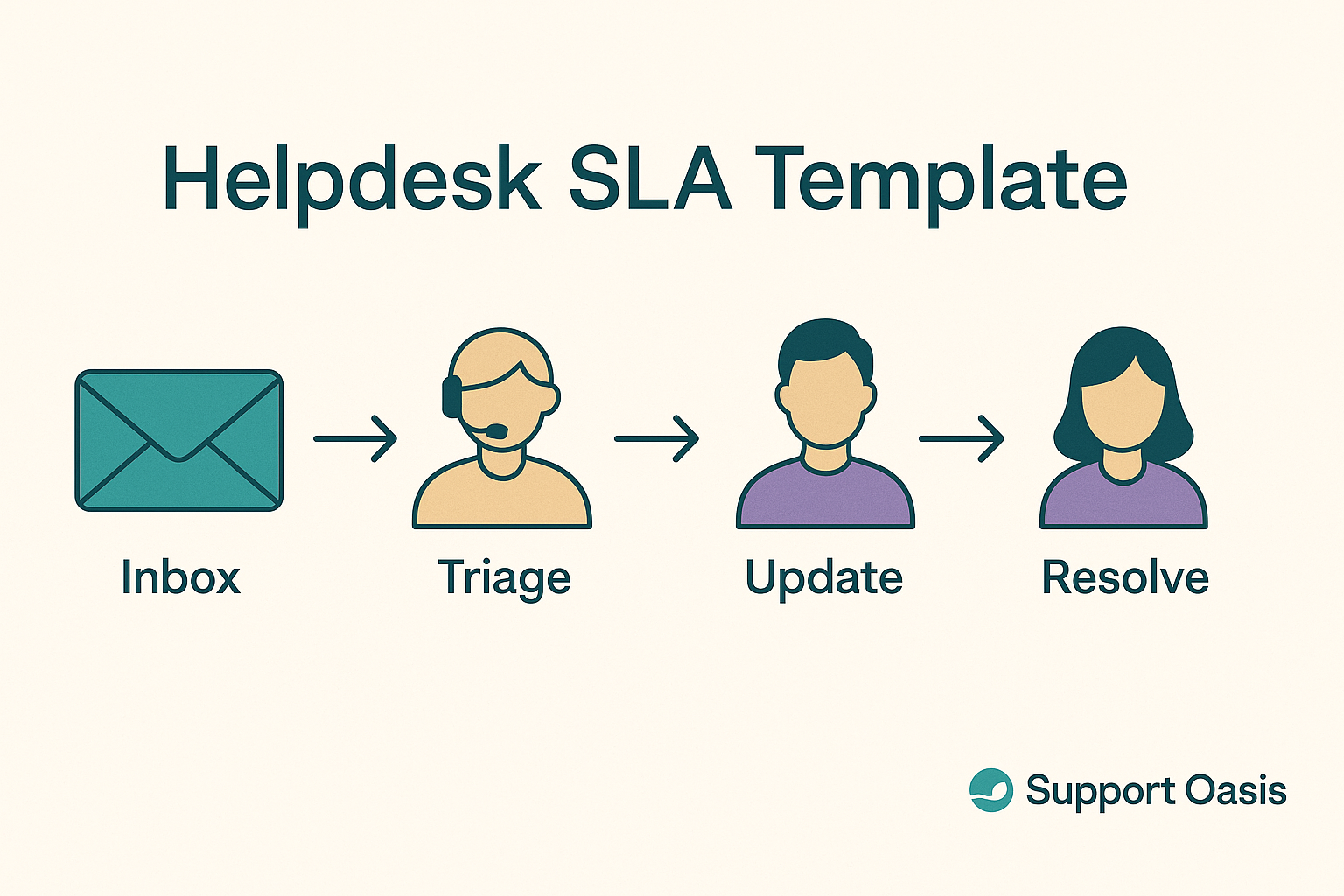A clear helpdesk SLA template keeps small, email-first teams aligned on speed, updates, and ownership. In this guide, you get a copy-ready checklist, realistic response targets, and simple escalation rules that prevent breaches. As a result, customers stay informed and agents focus on the next right action.
Helpdesk SLA Template Basics
An SLA is a short agreement that sets response and resolution expectations. Small teams need a lightweight version that matches inbox reality. Therefore, define scope, hours, channels, priorities, response targets, resolution targets, escalation triggers, and update cadence. Publish it where customers can find it, and review it on a regular schedule. For background, see BMC’s practical SLA template examples.
Helpdesk SLA Template Checklist
Copy this checklist and replace placeholders.
- Scope: customer email support for product issues and questions
- Support hours: Monday to Friday, 9:00–17:00 local time
- Channels covered: email only
- Priorities: P1 urgent, P2 high, P3 normal
- First response targets: P1 1 hour, P2 4 hours, P3 same business day
- Next-response cadence: P1 every 2 hours, P2 twice daily, P3 daily
- Resolution targets: P1 same day, P2 2 days, P3 5 days
- Escalation triggers: breach risk at 75% of target or customer request
- Update standard: each message includes a “next update by” time
- Measurement: track first response, next response, resolution, and breaches
Try Support Oasis for free to set and track SLAs without spreadsheets. Try for free.
Set Response Time Targets That Fit
Targets must be credible. First, estimate coverage hours and typical inbox volume. Next, estimate average handle time per ticket. Consequently, you can size targets that the team can meet. Keep P1 aggressive and P3 forgiving. Moreover, review numbers monthly and adjust as your volume changes.
First Response vs Resolution Time
First response time measures the delay to your first human reply. Full resolution time measures the time to close. Customers judge speed on the first reply; however, loyalty depends on steady progress and clear updates.
Escalation Rules and Update Cadence
Escalation defines who takes over and when. Use time-based triggers and event triggers. At 75% of any target, escalate to the next tier. Also escalate on customer request or repeat contact. Document who owns the ticket after each escalation. In addition, send updates on a fixed cadence so customers always know what comes next.
Saved Replies for SLA Updates
Prepare three short messages now. As a result, updates stay consistent and fast. For more copy, see Helpdesk Saved Replies: 15 Templates for Small Teams.
- Breach-risk warning: “We received your message and are still working. Next update by {time}.”
- In-progress: “We are working on this now. Next update by {time}. Thank you for your patience.”
- Resolved: “This request is resolved. If you still see the issue, reply to reopen.”
Examples: Service Level Agreement Samples
Use these short samples in your knowledge base.
Sample 1: General Email Support SLA
Hours: Mon–Fri, 9:00–17:00. Channel: email. First response: P1 1 hour, P2 4 hours, P3 same day. Next-response cadence: P1 every 2 hours, P2 twice daily, P3 daily. Resolution: P1 same day, P2 2 days, P3 5 days. Escalation: at 75% of target or on request. Updates: each reply includes a next update time.
Sample 2: Priority Table
| Priority | First response | Next-response cadence | Resolution target | Owner |
|---|---|---|---|---|
| P1 Urgent | 1 hour | Every 2 hours | Same day | On-call |
| P2 High | 4 hours | Twice daily | 2 days | Team lead |
| P3 Normal | Same day | Daily | 5 days | Assignee |
Put Your SLA to Work in Support Oasis
Set priorities, add saved replies for acknowledgments and updates, and track first response and resolution automatically. For a quick foundation, see Email-Based Helpdesk: Simple Setup for Small Teams and How to Set Up a Helpdesk for Your Small Team in One Day.
Quick Wins
- Add first response targets to your auto reply today
- Promise the next update time in every message
- Escalate at 75% of target to avoid breaches
- Review targets monthly and adjust to volume
FAQ
What should my first response time be for a small team?
Aim for same day on normal tickets, 4 hours for high, and 1 hour for urgent. Then refine as your data grows.
Do I need different targets for different priorities?
Yes. Shorten targets as impact rises. Use clear labels like P1, P2, and P3.
How do I avoid missing an SLA on busy days?
Use an escalation trigger at 75% of the target. Send an update with a promised next time.
Where should I publish our SLA?
Post it in your knowledge base and link it in your email signature. Also share it during onboarding.
Final Thoughts
This helpdesk SLA template aligns your team and your customers. Because you chose realistic targets and clear updates, you reduce breaches and build trust. Start simple, improve monthly, and keep communication steady.
Ready to act?
Try Support Oasis for free to launch email ticketing, saved replies, and SLA tracking in minutes. Try for free or learn more about Support Oasis.
